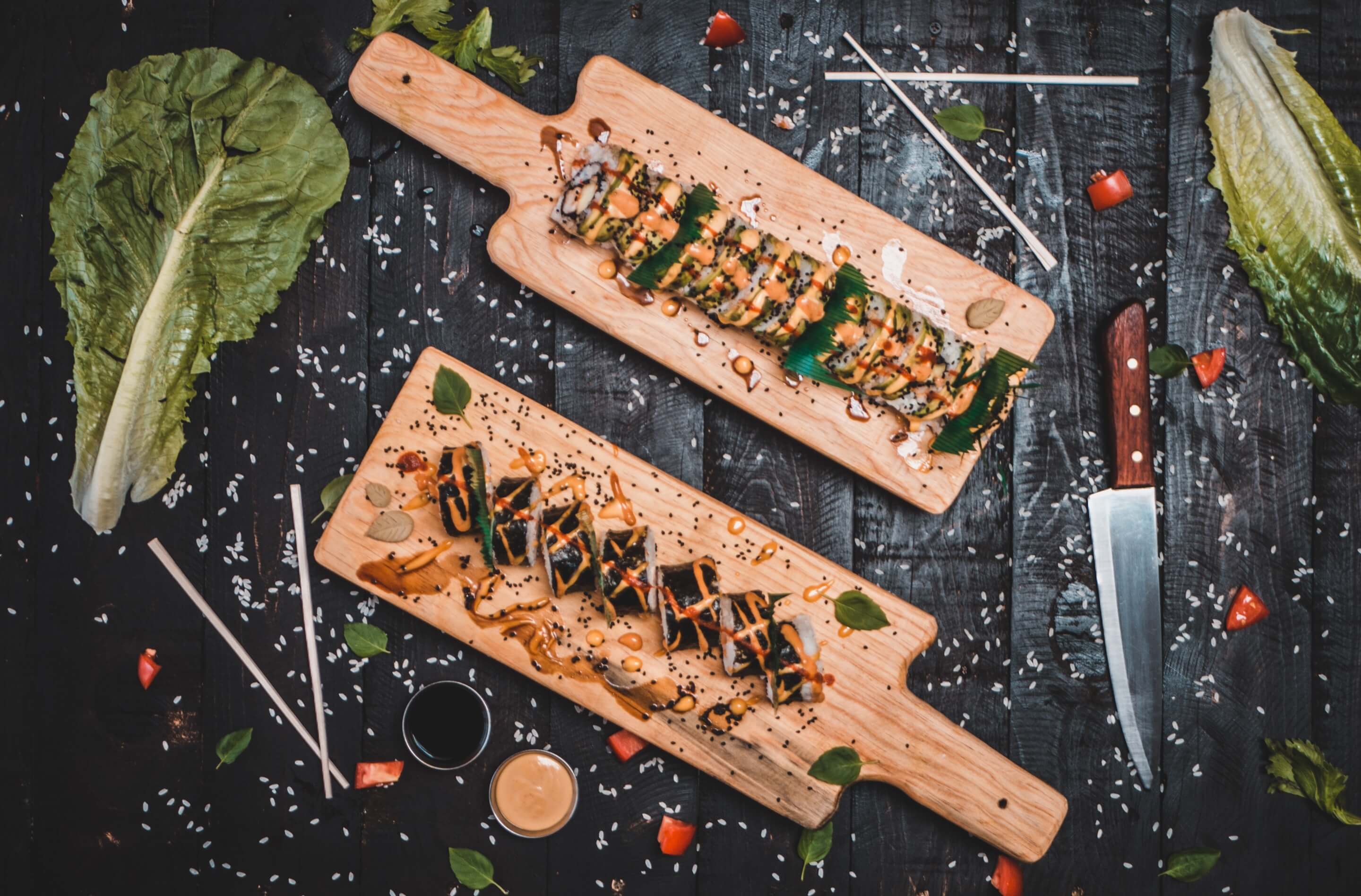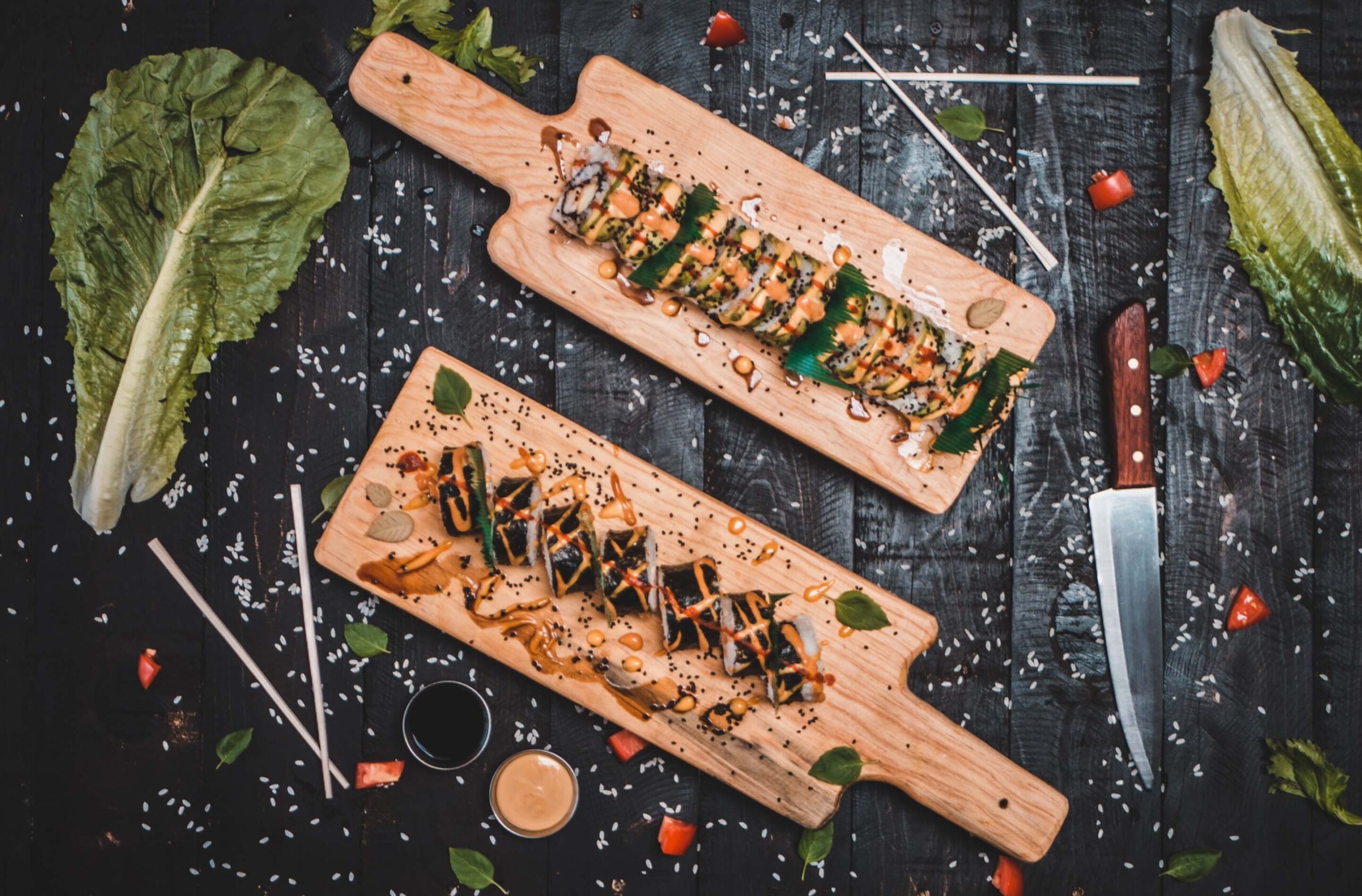Sushi as a style of food began as a way of preserving fish. In the 7th century, the mountain people of Southeast Asia invented the technique of pickling. The Japanese acquired this same practice that consists of pressing cleaned fish between rice and salt by a heavy stone for a few weeks and subsequently using a lighter cover for the packing process until the fish was considered ready to eat. During the process of fermentation, the rice produces a lactic acid, which in turn caused the pickling of the pressed fish. The finished edible product that results from this early method of sushi processing is known as naresushi, a sushi made with carp. It was customary at that time to only eat the fish and discard the rice. Since preparing naresushi entails a lengthy and arduous process that ranges from 2 months to more than a year, the process was perceived as too time-consuming and a waste of good rice.

M ost Americans enjoy sushi and believe they are making a healthy choice when dining on Japan’s single most popular food. In the last 40 years sushi has changed, been adopted by various cultures and diets and become more versatile than ever.
A Japanese Proverb
There is a Japanese proverb that says that if you have the pleasant experience of eating something you have not tasted before, your life will be lengthened by seventy-five days

What is Sushi?
Sushi as a style of food began as a way of preserving fish. In the 7th century, the mountain people of Southeast Asia invented the technique of pickling. The Japanese acquired this same practice that consists of pressing cleaned fish between rice and salt by a heavy stone for a few weeks and subsequently using a lighter cover for the packing process until the fish was considered ready to eat. During the process of fermentation, the rice produces a lactic acid, which in turn caused the pickling of the pressed fish. The finished edible product that results from this early method of sushi processing is known as naresushi, a sushi made with carp. It was customary at that time to only eat the fish and discard the rice. Since preparing naresushi entails a lengthy and arduous process that ranges from 2 months to more than a year, the process was perceived as too time-consuming and a waste of good rice.

Sushi Comes in Many Forms
Examining the etymology of sushi, the word Su means vinegar, and meshi, meaning rice, were combined into “sumeshi”. When the word is pronounced very quickly, the word merges and is shortened into the bi-syllabic sound of “sushi”.
Sushi can be categorized into 3 main types: nigiri, maki, and temaki. Nigiri sushi has a uniquely minimalist appeal. It is often served as raw fish, salmon eggs, cooked shrimp, or sliced egg on rice and is usually ordered in pairs. Maki sushi is also known as roll sushi. The versatility in its design and presentation makes this form of sushi a very popular choice among sushi fans. Sushi novices find maki rolls particularly appealing, since the many ingredients of the roll combine into a pleasing taste that completely dispels any physical or psychological squeamishness associated with consuming raw fish. Maki sushi is rolled with rice and sheets of seaweed (nori) and sliced into 6 or 8 bite-sized pieces. The 3rd type of sushi is temaki or “handroll.” Temaki is rolled by hand into a cone shape. Temaki usually contains larger pieces of vegetables and smoked salmon.
While the levels of sugar vary, sushi is definitely not a sugar-free food, even though it’s one you probably don’t associate with sweeteners.
Sushi rice itself is prepared with sugar and rice vinegar; each cup of sushi rice requires about a tablespoon of sugar. Short-grain rice, the type used for sushi, is higher on the glycemic index. If you’re pre-diabetic, it’s dangerous having elevate blood sugar levels. And even if you’re not, too much sugar has been linked to weight gain, increased bad cholesterol, heart disease, liver problems, hypertension and more.
The sauces used in sushi are loaded with sugar as well. In fact, many of them, like soy sauce used for dipping are thickened with sake or mirin, drastically increasing the sugar intake while making it thicker.
Considering the Pro’s and Cons
Are your sushi rolls are full of unhealthy ingredients?
Wild-caught fish like tuna and salmon are great for you. They’re full of healthy omega-3’s that help protect your heart and brain, and they’re packed with protein. Unfortunately, that’s probably not always the fish you’re getting. More likely you’re being fed farmed fish, which are raised with the use of antibiotics, pesticides and dangerous chemicals. These fish farms produce an enormous amount of excrement and pathogens, which in turn harms other sea life and provides a breeding ground for bacteria. Feeding the fish in fish farms also leads to overfishing of smaller fish species like wild sardines and herring and decreases biodiversity.
If you’ve ever wondered how some sushi restaurants, or supermarkets can afford to sell sushi so cheaply, this is probably why; they’re paying pennies for farmed fish. Of course, that’s if you’re even getting what you believe you’re ordering.
A study out of UCLA examined the fish ordered at 26 different L.A.-area restaurants over four years. They found that 47 percent of the fish used in sushi was mislabeled. While tuna and salmon were usually what they said (salmon was mislabeled 1 out of 10), halibut and red snapper orders were almost always ended up being a different type of fish. Maybe an honest mistake, but one of the study’s authors doesn’t think so.
Eating sushi weekly has been linked to higher-than-safe mercury levels. Mercury in fish is connected to serious health issues, particularly in children and pregnant women, ranging from developmental disabilities to shortened attention spans and learning disabilities.
But, wait I’m eating healthy fatty fish, right? You’re not if you’re eating fish that’s got higher levels of mercury (usually tuna, swordfish, shark and mackerel) because of the healthy benefits that fish have, you’re out of luck. It turns out that too much mercury actually cancels out the positive benefits of omega-3s and increases your risk of cardiovascular disease. In addition, large tuna like Atlantic Bluefin and Bigeye, which are prized for sushi, not only have the highest mercury levels, but they’re also in jeopardy of being overfished to satisfy the needs of sushi eaters.
Hidden Ingredients
What is “Imitation Crab”?
The primary ingredient of imitation crab is a type of gel-like substance known as kani surimi, which is made by grinding different types of fish into a thick paste, then adding in starch, fillers, artificial flavoring and food coloring to mimic the taste, texture and appearance of real crab. Pollock is the most common fish used to produce imitation crab meat due to its lack of flavor, abundance and ready availability, but other types of fish like cod, mackerel and barracuda are sometimes used as well. It’s estimated that 2 million to 3 million tons of fish around the world, or about 2 percent to 3 percent of the world fisheries supply, are used to produce surimi-based products, such as imitation crab meat.
Because of its sparse nutrient profile and long list of additives, many people consider it to be the seafood equivalent of the hot dog, made of fish parts and questionable ingredients that have been ground up into a cheap, highly processed convenience food. Imitation crab is a common ingredient in many types of cuisine, favored for its versatility, low cost and ease of preparation. Being significantly cheaper than regular crab meat, it has become a popular choice for everyone from food manufacturers to restaurants and consumers.
It’s Not All Bad
In the rolled variant (maki), a special bamboo mat is used and nori (a thin sheet of prepared seaweed) is wrapped around the rice and fillings such as egg, avocado, mango or cucumber. Nori contains significant amounts of vitamins A, B1, B2, B6, B12, C, niacin, and folic acid, the vitamin C content can decrease in the drying.
While sushi has many healthy elements, its preparation and seasoning can take away from the overall nutrition. For example, rolls dipped in tempura and fried and then covered with creamy sauce will not be the same as those wrapped solely in nori and packed with fish, rice and vegetables. In terms of health and longevity, the Japanese diet has significantly contributed to longer lifespans, and that’s in part due the fish they eat, many of which are high in Omega-3 fatty acids, and are found in different types of sushi. If you’re looking for the better choices nigiri (thin slices of raw fish topped over small balls of vinegared rice) and sashimi (thin slices of raw fish), alongside a salad and side of cooked vegetables, which are great sources of fiber and micronutrients.
Or you could order “Naruto-style” which is a roll wrapped in cucumber. It is fun, crunchy, and makes a great healthy option in addition to traditional sushi menu options. However, if you’re craving rolled sushi, choose healthier types of fish like salmon and mackerel (which are low in mercury). Avoid high-sodium soy sauce and go for other healthy flavor enhancers like wasabi or pickled ginger (gari).
Make Your Sushi Helathier
1. Eat sashimi. Though sashimi is technically not sushi, this is the best way to enjoy a dinner out at a sushi restaurant. Sashimi is way healthier; it’s literally just the fish without any of the extra sauces or rice accompanying it. Of course, you still run the risk of not getting the right type of fish but if you’re willing to take the risk of eating sushi, this is the type to go for.
2. Use coconut aminos instead of soy sauce. Get rid of the GMO soy and use coconut aminos instead. This alternative is soy-free, but tastes just like soy sauce. It’s perfect for dipping rolls into without the fear of soy side effects.
3. Pile on the veggies and ginger. Perhaps skip the fish altogether and load up on veggie rolls. More places are getting creative with their vegetable fillings, letting you enjoy a sushi-like experience without the fear of eating bad fish.
You can also swap out wasabi for fresh ginger. Did you know that ginger is actually the most widely used condiment in the world? It’s a staple in Asian diets, which have long recognized its anti-inflammatory and healing properties. Instead of adding food dyes to your plate, try sneaking in some ginger.
4. Ask for brown rice instead of white. Unlike its white counterpart, brown rice is actually good for you (in small doses, of course!). It’s high in fiber and nutrients, making it a much healthier option than the refined carbs that are white rice.
5. Make your own sushi! You knew this was coming — make your own! It’s actually really easy to prepare your own sushi at home. When you do this, you have full control of what’s going in and what you’re consuming. You can enjoy your meal instead of worrying about what you may or may not be eating.






Leave A Comment